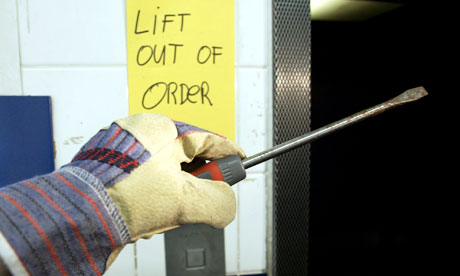For the last 10 years, Ian and Linda Cameron have lit up the top floor of their tower block with a sparkling display of festive lights, enjoyed by thousands of people who can see them from miles around.
But this year the council told them to take them down because they are too dangerous.
The couple live on the 19th floor of Brighton's second highest clocks of council flats, right in the city centre, and for many, the switching on of their lights is the unofficial start to the Christmas season.
Last summer tenants in the block were ordered to remove their doormats from internal corridors because they were considered a fire risk.
Mrs Cameron, 53, said: "Now they are picking on our fairy lights. A woman from the housing office called me at home and told me to take them down immediately.
"I was quite upset because she talked to me like I was some kind of criminal. We only put them on when we are at home and turn them off at bedtime.
"I asked why and she simply said: 'Health and Safety.'
"Have they got nothing better to worry about?"
A Brighton and Hove Council spokesman said: "There is no suggestion that this action is 'suddenly' necessary. In fact, we are responding to a complaint from a member of the public and were not previously aware these lights were being suspended so high above the ground. Far from being 'health and safety gone mad', this is common sense.
"Where electric lights are being hung more than 100 feet high, we have a duty to ensure they are not a danger to passers-by."
Mr Cameron, 63, said: "People can see our lights right across the city. I've looped them along the balcony, which stretches half way round the top floor, every year since we moved in a decade ago and nobody has ever said anything before.
Read more at The Telegraph
Last summer tenants in the block were ordered to remove their doormats from internal corridors because they were considered a fire risk.
Mrs Cameron, 53, said: "Now they are picking on our fairy lights. A woman from the housing office called me at home and told me to take them down immediately.
"I was quite upset because she talked to me like I was some kind of criminal. We only put them on when we are at home and turn them off at bedtime.
"I asked why and she simply said: 'Health and Safety.'
"Have they got nothing better to worry about?"
A Brighton and Hove Council spokesman said: "There is no suggestion that this action is 'suddenly' necessary. In fact, we are responding to a complaint from a member of the public and were not previously aware these lights were being suspended so high above the ground. Far from being 'health and safety gone mad', this is common sense.
"Where electric lights are being hung more than 100 feet high, we have a duty to ensure they are not a danger to passers-by."
Mr Cameron, 63, said: "People can see our lights right across the city. I've looped them along the balcony, which stretches half way round the top floor, every year since we moved in a decade ago and nobody has ever said anything before.
Read more at The Telegraph











